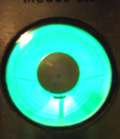Conar 230 Signal Tracers in black wrinkle case and blue case with handle.
Conar Model 230 Signal Tracer
I enjoy using pieces of test equipment that are complete radios in themselves.
The Conar Model 230 Signal Tracer is another complete TRF radio. The Conar 230 was sold as a kit by NRI, the National Radio Institute. NRI offered correspondence courses in radio and electronics. They also sold some decent test equipment and a couple of ham radio pieces as kits under the Conar brand. Earlier, they also sold kits under the NRI brand. Click on this link to see the Model 33 signal tracer which contains a complete four-band TRF radio. Using a TRF radio as part of a test instrument was popularized by Rider in his Rider Chanalyst.
The Conar 230 uses an untuned front end (in the probe) followed by two stages of TRF followed by a diode detector and 2 stages of audio. The TRF covers from 170 KHz to 1500 KHz in two ranges. Those frequencies include commonly used IF frequencies in AM and shortwave radios as well as much of the AM broadcast band. It contains 7 tubes including a 6AB4 as cathode follower preamp (in the probe), two 6GM6 for RF amps, 6AV6 as detector & first audio, 6E5 eye tube, 6AQ5 for audio output, and a 6X4 rectifier. A front-panel switch allows use as an audio signal tracer.

Repairs
Both of these units needed all of their controls cleaned with contact cleaner and the electrolytics reformed. A full alignment was done per the instructions in the manual using a signal generator. No other servicing was needed. An excellent copy of the manual with schematic can be downloaded from BAMA in PDF form. Note that the variable capacitor has B+ on the stator (the non-moving part of the cap).
Usefulness of the Conar 230. That nice warm probe in action.
Like all of the TRF signal tracers, the Conar 230 is very useful for tracing a radio signal through all the radio stages from the antenna to the audio output. Of the TRF-style signal tracers, the Conar is somewhat unique in having a vacuum tube in the probe itself.
It is also fun to use one of these to listen to AM broadcasts as a TRF radio. A TRF radio with an untuned front end allows for wide-band frequency response. Selectivity is somewhat inversely proportional to signal strength. Strong signals occupy a much wider spectrum than weaker signals.
A permanent place on the bench
The Conar 230 in the black-wrinkle case now occupies a conspicuous spot on my test equipment shelf above the repair bench.
5-7-06
A Johnson Viking I transmitter was the previous item on the bench.